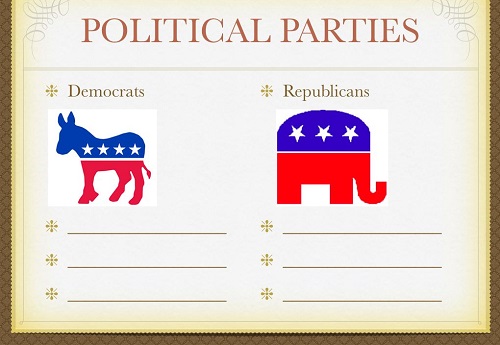Difference Between Political Parties and Interest Groups
Political parties and interest groups are entities that act as intermediaries between the population and the political sphere. Groups and parties bring together people with similar ideas and visions on specific or broader issues, including economics, migration, taxes, welfare, healthcare, and so on. Although political parties and interest groups are quite different, they are both means through which citizens can deepen their knowledge on political and social issues and can become informed voters. In general terms, political parties aim at winning elections and focus on various issues; conversely, interest groups do not participate in the electoral process but are deeply involved in lobbying and are generally focused on one or two specific issues.
What are Political Parties?
A political party exists to gain power through elections by supporting one or more candidates. For instance, in the United States, Republicans and Democrats are the two main political parties and, every four years, new (or old) candidates are put forward by the two parties to run for elections. Political parties focus on a variety of issues, including:
- Social welfare;
- Equality of rights;
- Gun control;
- Taxes;
- Foreign relations; and
- Health care.
A political party can include all citizens that identify with the party itself – even if they are not officially registered. Political parties aim at gaining power by supporting their candidates, they can be flexible about different issues and they are often criticized for prioritizing the interests of politicians rather than the needs of the population.
What are Interest Groups?
Interest groups are groups of people that share similar ideas on specific issues and that come together to influence public opinion. Yet, interest groups do not run for elections and do not necessarily support individual candidates but they do seek the abolition or the approval of specific laws by lobbying and campaigning. Interest groups can include:
- Corporations;
- Businesses;
- Labor unions;
- Social groups; and
- Student unions.
Interest groups focus on specific issues, like gun control, environmental laws or minimum wages. They are usually not flexible and their strength largely depends on their size and on their influence on the broader population as well as on their ability to lobby politicians or influential individuals.
Similarities between Political Parties and Interest Groups
Although they are different in substance, political parties and interest groups share some common features:
- Both interest groups and political parties are created by individuals with common ideals, visions, and goals;
- Both aim at achieving some sort of social, political or economic change;
- Both use lobbying techniques to achieve their goals and to get influent individuals, corporations or politicians to support their cause;
- Both employ similar techniques to promote their ideas – including campaigning, raising money and raising awareness; and
- Both can allow citizens to gain a better understanding on specific issues and to make informed decisions.
Difference between Political Parties and Interest Groups
Political parties and interest groups differ on various levels: they can have different sizes, they can be focused on different issues and they can have different goals. The main difference between the two concerns their primary purpose: political parties aim at achieving power over governmental policy by supporting a candidate and winning elections; conversely, interest groups are created to promote a position or a view on specific issues but do not have members running for office. As such, interest groups often vote for candidates – who are put forward by political parties – who share their point of view. Other differences between the two include:
- Political parties are more flexible than interest groups as they aim at achieving the support of the majority of their population in order to maximize their chances of winning elections. Conversely, interest groups are not flexible but focus on one issue (i.e. gun control) and promote their ideas trying to unite like-minded people;
- Not all members of political parties have the same views on every issues. Political parties, in fact, focus on a variety of different aspects (i.e. education, taxes, migration, etc.) and interest groups surrounding one or more of the central issues often arise within political parties. Conversely, interest groups focus on specific issues and all members share the same view (i.e. pro or against abortion, or pro or against gun control, etc.); and
- The size of political parties does not necessarily affect their chances of winning elections; conversely, the size of an interest group has a strong influence on the group’s ability to gain influence and to promote its views.
Political Parties vs Interest Groups : Comparison Table
Building on the differences highlighted in the previous section, we can identify few other aspects that can differentiate political parties from interest groups:
| Political Parties | Interest Groups | |
| Political participation | Political parties are deeply involved in the electoral process and in the political sphere of the country. They run political campaigns and support one (or more) of their members in the run for office. | Interest groups are involved in the political sphere of the country but they do not directly participate in elections, although they can support one candidate or one political party that shares their point of view. |
| Independence | Political parties are often accused of prioritizing the interests of influent individuals or rich corporations that support their political campaigns with generous donations. | Interest groups try to raise money and awareness to promote their ideas and engage in lobbying activities, but are often more independent than political parties – although they can be employed by corporations or politicians to promote a specific (and manipulated) view. |
Summary points on difference between Political Parties and Interest Groups
Political parties and interest groups are groups of people that share similar views and ideas. Political parties focus on a larger variety of issues and aim at achieving power by winning the electoral process; conversely, interest groups have a narrower focus and do not participate in elections. Not all members of a political party have the same ideas, but all members of an interest group are deeply committed to the ideal and the view of the group and engage in fundraising and lobbying activities to promote their point of view.
- Difference Between Michelle Obama and Melania - January 29, 2019
- Difference Between Trump and Modi - December 4, 2018
- Difference Between Carbon Tax And Cap And Trade - December 4, 2018
Search DifferenceBetween.net :
Leave a Response
References :
[0]Burstein, Paul, and April Linton. "The impact of political parties, interest groups, and social movement organizations on public policy: Some recent evidence and theoretical concerns." Social Forces 81.2 (2002): 380-408.
[1]Thomas, Clive S. "Political parties and interest groups: Shaping democratic governance." (2001).
[2]"Image Credit: http://wiki.bssd.org/index.php/Political_parties"
[3]"Image Credit: http://princessjulianna.wikispaces.com/"


